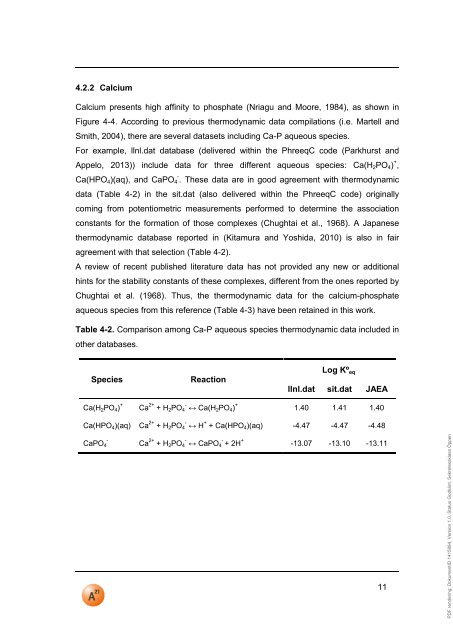pH = 11 - SKB
pH = 11 - SKB
pH = 11 - SKB
You also want an ePaper? Increase the reach of your titles
YUMPU automatically turns print PDFs into web optimized ePapers that Google loves.
PDF rendering: DokumentID 1415884, Version 1.0, Status Godkänt, Sekretessklass Öppen4.2.2 CalciumCalcium presents high affinity to phosphate (Nriagu and Moore, 1984), as shown inFigure 4-4. According to previous thermodynamic data compilations (i.e. Martell andSmith, 2004), there are several datasets including Ca-P aqueous species.For example, llnl.dat database (delivered within the PhreeqC code (Parkhurst andAppelo, 2013)) include data for three different aqueous species: Ca(H 2 PO 4 ) + ,Ca(HPO 4 )(aq), and CaPO - 4 . These data are in good agreement with thermodynamicdata (Table 4-2) in the sit.dat (also delivered within the PhreeqC code) originallycoming from potentiometric measurements performed to determine the associationconstants for the formation of those complexes (Chughtai et al., 1968). A Japanesethermodynamic database reported in (Kitamura and Yoshida, 2010) is also in fairagreement with that selection (Table 4-2).A review of recent published literature data has not provided any new or additionalhints for the stability constants of these complexes, different from the ones reported byChughtai et al. (1968). Thus, the thermodynamic data for the calcium-phosphateaqueous species from this reference (Table 4-3) have been retained in this work.Table 4-2. Comparison among Ca-P aqueous species thermodynamic data included inother databases.SpeciesReactionLog Kº eqllnl.dat sit.dat JAEACa(H 2 PO 4 ) + Ca 2+ + H 2 PO 4 - ↔ Ca(H 2 PO 4 ) + 1.40 1.41 1.40Ca(HPO 4 )(aq) Ca 2+ + H 2 PO 4 - ↔ H + + Ca(HPO 4 )(aq) -4.47 -4.47 -4.48CaPO 4-Ca 2+ + H 2 PO 4 - ↔ CaPO 4 - + 2H + -13.07 -13.10 -13.<strong>11</strong><strong>11</strong>
















